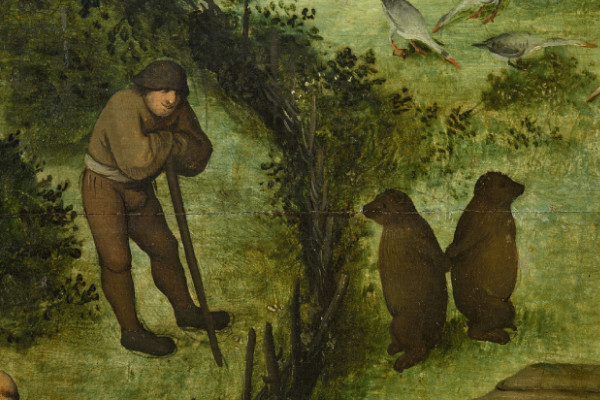Proverbs and Process
- February 02 2025
- 4 min read
For this post, a $50 CAD donation was made to FANTOM, the Fédération pour les arts nocturnes comprenant les travailleur·euses et organisateur·ices de Montréal. They're "a non-profit collective created by and for queer/trans/BIPOC/ally underground nightlife and after-hours artists, workers, and organizers." You can learn more about them and their essential work here.
This year, I’m making an effort to leave positive reviews on small or overlooked games on Steam I’m enjoying. Every little bit helps, and it feels nice to support a game and its creators as they try to break through that 500-review threshold. Every now and then, a game might even inspire me to write up a blog post to talk about it in more detail!
One such game is Proverbs by Mark Ffrench.
Clicking
The gameplay itself is straightforward. Similar to Minesweeper, you have a grid that needs to be filled in correctly based on numbered clues. The number represents the quantity of surrounding tiles (within one square’s distance orthogonal or diagonal to it) that need to be marked. You can click it (with a satisfying sound and animation that plays) to mark it as filled or empty. All clear? Nothing out of the ordinary here.
What sets Proverbs apart, though, and what really makes it special, are three things:
1. The scale of it. The grid is massive, encompassing over 54,000 tiles. Truly, it’s enormous. Like massive crossword or jigsaw puzzles, the enjoyment comes from the slow, incremental progress on something that feels impossibly large. As a game, Proverbs excels within small windows of leisure time, while idling around, or multitasking. At its scale, the grid functions as both a threat and a promise: “Oh, you like logic puzzles? How about fifty thousand of them?” and “Watch me.”
2. The shape of it. Although the full grid is a rectangle, it’s made up of hundreds of regions that contort and stretch to all manner of different shapes and sizes. This allows for interesting and natural variation in difficulty, as well as an opt-in way to approach it: How much time do you have to spare? Are you up for a challenge? Or are you in the mood for a breezy, tiny region? Like a jigsaw puzzle, do you start with the border first? Are you filling it in left-to-right? Or haphazardly picking regions that suit you in the moment?
3. The content of it. Although the “pattern” within each region is mostly random noise, as soon as you complete it, it transforms into an image. Because each region matches to a pixel-art rendition of a section of a painting by Peter Bruegel the Elder called Netherlandish Proverbs. In fact, nearly every region is a visual representation of a Netherlandish saying, accompanied by a written explanation.

"What? Haven't you seen two bears dancing and holding hands before? Leave us alone, man."
Looking
All art asks us to engage with it. To be active participants in its experience. Whether that’s music, or a movie, or a painting. The problem is that this doesn’t come naturally for everyone. In fact, it’s usually something we need to train ourselves to be better at: looking, listening, feeling. There is so much to understand about the art itself and about ourselves if we give it the time, focus, and consideration it deserves. This is the work of critics, as they experience art through different lenses or consider it in conversation with other art, but it’s also the work of those with a deep love and respect for the craft.
Proverbs is fascinating to me because it is provoking its players to examine art, and images, more closely (a skill that’s becoming all the more necessary with the influx of AI-generated slop). What might seem chaotic at first glance is in fact richly layered and deep with intentional meaning, if only we had the time and effort to properly explore it. And it feels to me like Proverbs wants to provide Netherlandish Proverbs with that opportunity. Each proverb lets us laugh or puzzle over its meaning, to see how it contributes to the full tapestry, or to reflect on our role as players of games.
Mind you, I wish it was easier to examine the actual painting in full view, instead of the small excerpts that accompany each proverb. I also wish there was a little blurb that talked a bit about the painting and the painter, to provide some added context and commentary… but it’s still encouraging me to explore it for myself. And that’s exciting! To have a game centered on a single piece of art that lets you experience it in small sections at a time before beholding the full work as a whole is such a compelling concept! Proverbs is a game about looking and deciphering meaning.
Making
Proverbs is also a game about making art. You can feel it in the first moments you boot up the game. It’s that feeling that comes when you start a new project and first behold a blank canvas. That thrill of leaping into the unknown, the tension from seeing if you can realize a thought into physical being, and the joy that comes from seeing your labour manifest as changes to your canvas… something beautiful, surprising and curious, all at once.
It’s the feeling of pointing to a landmark in the far distance, whispering to yourself, “I can reach it,” and setting out to see if you can follow through on that promise. So much of the process of making art is exhilarating! It’s a celebration for both the journey and the destination, and Proverbs is no different. The game shows you its boundaries and charges you with seeing it through, square by square. There’s an honesty in its forthrightness and a real pleasure in seeing the painting slowly come alive.
It’s a perfect game, and I mean that sincerely, in that it’s a concept that’s executed and communicated well. That’s not as simple as it sounds! So many of our ideas get muddled along the way, from their first thoughts to the final experience. And Proverbs is a gentle reminder that our ability to communicate an idea well is the most important skill of all.
